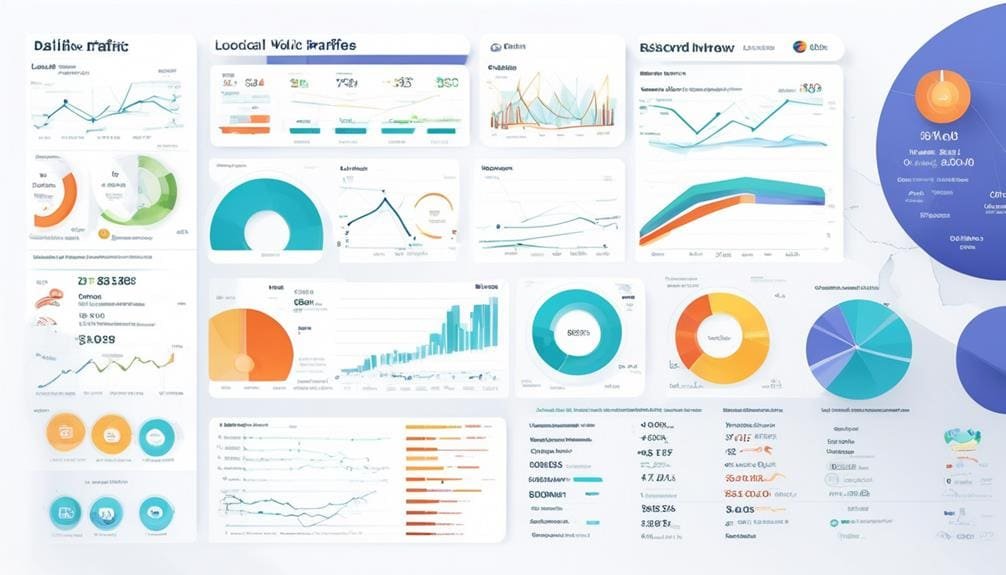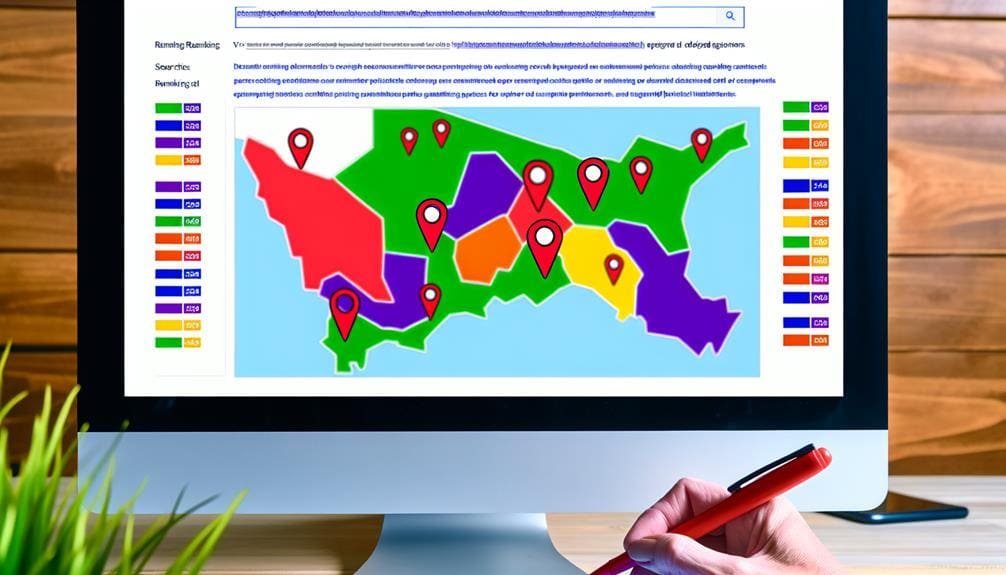13 Key Strategies for Regional SEO Competitor Analysis
April 7, 2024 | by Jacob Cavazos

We've all heard that 46% of all Google searches are seeking local information. But have you ever stopped to think about how your business measures up to the competition in local search results? In today's competitive digital landscape, understanding how your regional competitors are performing in terms of SEO is crucial for staying ahead. As we delve into the 13 key strategies for regional SEO competitor analysis, we'll uncover actionable insights that can help you not only understand your competitors' strategies but also identify opportunities to elevate your own local SEO game. Whether you're a small business or a larger enterprise, these strategies will provide you with the tools to create a comprehensive competitor analysis report and inform your local SEO strategy effectively.
Identifying Local Competitors
When conducting a regional SEO competitor analysis, it is crucial to start by performing Google searches for our business's key services or products in our city or region to identify the local competitors. By noting the businesses appearing in the local search results and Google Maps results, we can create a comprehensive list of local competitors. It's important to consider both direct and indirect competitors to have a holistic view of the competitive landscape. This step is vital for developing effective local SEO strategies. Once we have a list of local competitors, we need to analyze their online presence and ranking factors to understand their local SEO strategies. This analysis provides valuable insights into the strengths and weaknesses of our competitors, helping us identify opportunities to improve our own local SEO strategy. Regularly monitoring and updating the list of local competitors is essential to stay informed about changes in the competitive landscape and to adapt our strategies accordingly. Conducting a detailed competitive analysis is the foundation for creating successful local SEO strategies and gaining a competitive edge in the local market.
Analyzing Local SEO Strategies
Let's start by analyzing local keywords to understand how competitors are targeting their specific geographic locations. Next, we'll delve into competitor citation research to evaluate their presence in local directories and the impact of their local backlinks. Lastly, we'll conduct a thorough audit of location-specific content to identify areas for improvement and differentiation in our local SEO strategy.
Local Keyword Analysis
Analyzing local keyword usage on competitors' Google My Business profiles and websites is a crucial step in understanding their local SEO strategies. When conducting local keyword analysis, we focus on several key aspects:
- Competitors' Local Search Keywords: Identifying the specific keywords and phrases that competitors are targeting in their local SEO efforts provides valuable insight into the most relevant terms for the local market.
- Localized Content and Meta Tags: Examining the content and meta tags on competitors' websites can reveal the local keywords they prioritize, offering inspiration for our own localized content strategy.
- Google My Business Keyword Optimization: Assessing how competitors optimize their Google My Business profiles with local keywords helps us understand their approach to local search visibility and informs our own optimization efforts.
Competitor Citation Research
In our analysis of competitor citation research for local SEO strategies, we thoroughly evaluate competitors' Google My Business profiles, local backlinks, and presence in local directories to gain crucial insights into their local search visibility tactics. This involves comparing keyword strategies, Google My Business profiles, reviews, backlink profiles, and local directory presence with competitors. Competitor Citation Research helps identify gaps in content, weak on-page SEO, backlink opportunities, and social media engagement of competitors. The process culminates in a comprehensive report summarizing the analysis, findings, and recommendations for refining the local SEO strategy. Local SEO Competitive Analysis involves identifying direct and indirect competitors, evaluating their local rankings, Google My Business profiles, and on-page optimization, and monitoring threats from competitor SEO changes.
| Competitor Citation Research |
|---|
| Identifying Competitors' GMB Profiles |
| Evaluating Local Backlink Profiles |
| Analyzing Presence in Local Directories |
| Comparing Keyword Strategies |
| Summarizing Findings and Recommendations |
Location-Specific Content Audit
Executing a thorough location-specific content audit is essential for gaining insights into the local SEO strategies of competitors and identifying opportunities for improvement. When analyzing local SEO strategies, we prioritize the following key actions:
- Evaluate Local Backlinks: Assessing the quality and quantity of backlinks from local websites can reveal link-building opportunities and potential gaps in the backlink profile.
- Examine On-Page Local SEO: Reviewing on-page elements such as title tags, meta descriptions, and headers for location-specific optimization can uncover areas for improvement in local search engine optimization.
- Assess Local Directories and Google My Business Profiles: Analyzing the presence and accuracy of local business listings in relevant directories and the completeness and optimization of Google My Business profiles is crucial for local SEO success.
Comparing Strategies
Let's kick off our discussion by looking at how to compare strategies effectively. First, we'll explore tool comparison to ensure we're using the best resources to gather and analyze data. Next, we'll delve into metrics analysis, focusing on the key performance indicators that matter most for our regional SEO efforts. Then, we'll tackle data interpretation to make informed decisions based on the comparisons we've made.
Tool Comparison
As we delve into the realm of tool comparison for regional SEO competitor analysis, we can leverage various techniques to gain valuable insights and refine our strategies. When comparing strategies, it's essential to consider the following:
- Keyword Strategy: Compare our keyword strategy with competitors to identify any high-volume keywords that may have been overlooked, helping us enhance our SEO efforts and improve our ranking in search results.
- Google My Business Profile: Evaluate our profile in terms of categories used, completeness, and engagement with reviews, ensuring it is optimized for maximum visibility and impact.
- Backlink Profiles and Local Directories: Assess our backlink profile and presence in local directories compared to competitors, identifying potential opportunities to strengthen our SEO competitive advantage.
Metrics Analysis
When comparing strategies for regional SEO competitor analysis, it is crucial to thoroughly evaluate our metrics to pinpoint areas of strength and identify opportunities for improvement. By comparing our keyword strategy with top competitors, we can uncover high-volume keywords that may have been overlooked. Assessing our Google Business profile in terms of categories used, completeness, and engagement with reviews is essential for enhancing our local search presence. Additionally, analyzing the quantity, quality, and responsiveness of our reviews compared to competitors can provide valuable insights. Evaluating our backlink profile and comparing it to our competitors' can reveal potential backlink opportunities for improving our search engine rankings. Lastly, comparing our presence in local directories with that of our competitors can help us identify areas where we need to strengthen our structured data to enhance our visibility in local search results.
Data Interpretation
Comparing our strategies for regional SEO competitor analysis involves interpreting data to uncover valuable insights that can drive our optimization efforts forward. When interpreting the data, we should focus on the following key areas to gain a competitive edge:
- Keyword Strategy: Compare competitive keywords to identify high-volume opportunities that may have been overlooked in our SEO strategy.
- Google My Business Profile: Evaluate our profile against competitors, considering categories, completeness, and engagement with reviews to enhance local SEO.
- Backlink Profile: Assess our backlink profile in comparison with competitors to identify potential opportunities for improvement and enhance search visibility.
Identifying Improvement Opportunities
To capitalize on missed opportunities and enhance our regional SEO competitiveness, we must meticulously identify gaps in our competitors' content and SEO strategies. By conducting a thorough analysis of our competitors' on-page SEO, user experience, and backlink profiles, we can pinpoint areas for improvement in our own website. This involves evaluating the keywords they are targeting, the quality and relevance of their content, and the effectiveness of their backlink strategies. Additionally, monitoring our competitors' social media engagement and successful posts can provide valuable insights to inform our own strategy.
Regularly updating our list of competitors is crucial for a comprehensive analysis. It's important to consider both direct and indirect competitors to gain a holistic view of the competitive landscape. By doing so, we can uncover valuable improvement opportunities that may have been overlooked.
Identifying improvement opportunities is not only about learning from our competitors' successes but also from their shortcomings. This proactive approach allows us to constantly refine and enhance our regional SEO strategy, ultimately positioning us for greater success in the competitive digital landscape.
Creating Competitor Analysis Report

As we move into creating the competitor analysis report, our focus shifts towards translating the insights gained from evaluating our competitors' strategies into actionable steps for enhancing our regional SEO competitiveness. This report serves as a valuable tool for refining our local SEO strategy and gaining a competitive edge in the market. Here's how we approach the creation of the competitor analysis report:
- Review SEO Competitors' Backlinks: We thoroughly analyze our competitors' backlink profiles to identify high-quality backlinks, understand their link-building strategies, and uncover potential link acquisition opportunities for our business.
- Assess Competitors' Content: We meticulously review the content strategies of our competitors, evaluating the types of content that resonate with the local audience, the keywords they target, and the engagement levels. This analysis helps us tailor our content strategy to better connect with our target audience.
- Identify Local SEO Improvement Opportunities: We pinpoint specific areas where our competitors outperform us, whether it's in terms of keyword targeting, local citations, or on-page optimization. By recognizing these areas, we can develop targeted strategies to enhance our local SEO performance and stay competitive in the market.
Utilizing Schema Markup
Implementing Schema Markup in your website not only provides search engines with essential details about your business but also enhances the visibility and relevance of your search results. It is a crucial part of SEO, especially when conducting competitor analysis. Schema Markup allows search engines to better understand the content on your website, making it easier for them to display relevant information to users. When analyzing the competitive landscape, it's important to consider whether your competitors are utilizing Schema Markup and how it is impacting their search visibility. By incorporating Schema Markup, businesses can gain insights into key elements such as operating hours, location, reviews, and other relevant details that can set them apart from competitors in search results. As part of the analysis, it's essential to evaluate how Schema Markup is being utilized by top-performing competitors and how it contributes to their overall search visibility. By understanding the impact of Schema Markup on the competitive landscape, businesses can make informed decisions to enhance their own SEO strategies.
Conducting Keyword Research

After enhancing our website with Schema Markup to improve search visibility, the next step is to conduct comprehensive keyword research to identify the most relevant and impactful keywords for our regional SEO strategy.
When conducting keyword research, we need to consider various factors to ensure the effectiveness of our strategy. Here's what we should focus on:
- Utilize Keyword Research Tools: We must leverage keyword research tools to identify the most relevant and high-volume keywords for our business. This will help us understand the search queries our target audience is using and tailor our content accordingly.
- Analyze Competitor Websites: It's crucial to analyze the keywords for which our competitors rank. By identifying the keywords they are targeting, we can uncover any gaps in our own keyword strategy and find opportunities to improve our SEO efforts.
- Explore Local and Long-Tail Keywords: Considering location-specific keywords and long-tail keywords is vital for targeting our regional audience effectively. These often provide opportunities for our business to stand out and capture niche search traffic that our competitors might be overlooking.
Leveraging YouTube for SEO
To effectively enhance our regional SEO strategy, we can leverage YouTube as a powerful platform for creating and sharing optimized video content to boost our visibility and reach. By tapping into YouTube's search engine capabilities and algorithms, we can improve our local SEO performance and rank higher for regional keywords. Incorporating relevant local keywords and geographic tags in our video titles, descriptions, and tags will enhance our local SEO, making it easier for local audiences to discover our content. Engaging with the local community through video content that showcases local events, businesses, and attractions can further strengthen our local presence and help us stand out against competitors. Additionally, utilizing YouTube analytics to track audience engagement will provide valuable insights for optimizing our video content and improving our local SEO performance. Here's a helpful table to guide you on leveraging YouTube for SEO:
| Action | Description |
|---|---|
| Optimize video titles and tags | Incorporate relevant local keywords and geographic tags to boost local SEO. |
| Create engaging local content | Showcase local events, businesses, and attractions to connect with the local community. |
| Analyze YouTube analytics | Track audience engagement and optimize video content for improved local SEO performance. |
| Engage with local audience | Respond to comments, interact with local viewers, and build a strong local community presence. |
| Collaborate with local influencers | Partner with local influencers to expand reach and enhance local credibility. |
Optimizing Google My Business

Leveraging YouTube for SEO has allowed us to effectively engage with our local audience, and now, optimizing Google My Business is the next crucial step in strengthening our regional SEO strategy. To optimize your Google My Business profile:
- Update Regularly: Keep your profile current with posts, photos, and offers to keep your audience engaged and informed about your business.
- Utilize Relevant Categories: Accurately represent your business by using relevant categories in your Google My Business profile.
- Manage Customer Reviews: Encourage and manage customer reviews to build trust and credibility, which can positively impact your local search rankings.
Optimizing your Google My Business profile is essential for improving your local search visibility and user experience. It's a powerful tool to help you rank higher in local searches and stand out from direct business competitors. By ensuring that your profile is complete, accurate, and regularly updated, you can strengthen your social media presence, enhance your organic search performance, and ultimately drive more traffic to your business.
Implementing White Hat SEO Techniques
Utilizing white hat SEO techniques is essential for establishing a strong online presence and enhancing the visibility of your website in organic search results. When implementing white hat strategies, it's crucial to analyze your competitors' websites to identify opportunities to improve your own site's performance. Start by focusing on creating high-quality, valuable content that naturally attracts links and shares. Ethical link-building strategies, such as creating shareable content and guest posting, can significantly improve your site's backlink profile. Additionally, engaging in community involvement can also enhance your site's authority and relevance.
Furthermore, prioritizing user experience is paramount. Optimizing site speed, ensuring mobile-friendliness, and providing relevant, authoritative content are essential for improving your site's organic search performance. Incorporating structured data markup can also help search engines understand your content better, ultimately improving the visibility of your site in search results. Lastly, don't overlook the importance of targeting relevant keywords and focusing on creating a strong local presence. By optimizing your Google My Business profile and obtaining local citations, you can significantly improve your site's local ranking and visibility.
Mastering Near Me Searches

Mastering near me searches involves leveraging local search data to understand and outperform your regional competitors. By focusing on near me searches, you can effectively target potential customers in your immediate vicinity and gain a competitive edge in local SEO. To master near me searches, we must:
- Identify Local Competitors: Utilize Google searches for your business's key services or products in your city or region to pinpoint local competitors. Take note of businesses appearing in local search results and Google Maps results to comprehend the local competition landscape.
- Regularly Update Competitor List: It's crucial to regularly monitor and update the list of competitors, considering both direct and indirect competitors. This ensures that you stay informed about the evolving competitive landscape in your region.
- Analyze Competitors' Local SEO Strategies: Analyze competitors' online presence, ranking factors, and Google My Business profiles to understand how competitors are ranking in near me searches. This analysis will provide valuable insights into effective local SEO strategies and help you refine your own approach to dominate in local search results.
Mastering near me searches empowers businesses to strategically position themselves in front of potential customers, thereby maximizing their local SEO impact and driving tangible results.
Focusing on Local Backlinks
After identifying local competitors and analyzing their local SEO strategies, our focus now shifts to maximizing local search visibility through the strategic acquisition of local backlinks. Local backlinks play a critical role in enhancing local SEO rankings, as search engines place significant emphasis on these links to determine the relevance and authority of a website within a specific geographic area. To stay ahead of competitors, it's crucial to analyze their local backlink profiles and identify potential opportunities for obtaining valuable local backlinks.
One effective strategy is to focus on acquiring backlinks from local businesses and blogs. By establishing connections with local entities, such as businesses, organizations, and influential individuals, you can significantly enhance your website's local search visibility. Additionally, leveraging local directories and community websites can provide valuable backlink opportunities, further strengthening your local SEO efforts.
To identify potential link opportunities, utilize tools like Ahrefs or SEMrush to assess and monitor competitors' backlink strategies. Tailoring your content to websites with high authority in the local area can also increase the likelihood of obtaining valuable backlinks. Incorporating local backlink acquisition as a key component of your local SEO strategy is essential for outperforming competitors and establishing a strong local online presence.
Enhancing On-Page Technical SEO

Enhancing on-page technical SEO involves conducting regular audits to identify and address any website issues that may affect search engine visibility and user experience. This is the starting point for optimizing your website and ensuring that it meets the technical standards required for improved search engine rankings. Here are some key actions to take:
- Check Your Competitors: Analyze the on-page technical SEO of your competitors to help you understand the keywords they are targeting, their meta descriptions, and how they structure their content. This insight can inform your own strategy and help you identify areas for improvement.
- Optimize Meta Tags and Headings: Ensure that your meta tags, headings, and URLs are optimized with relevant keywords to improve search engine visibility. Crafting compelling meta descriptions can also increase click-through rates from search results.
- Improve User Experience: Enhance website loading speed, mobile responsiveness, and overall user experience. Implement structured data markup, including schema markup for local businesses, to provide search engines with relevant information and improve visibility in local search results.
Frequently Asked Questions
How Do You Analyze Your Competitors SEO Strategy?
We analyze our competitors' SEO strategies by conducting thorough backlink analysis, keyword research, content comparison, on-page optimization, local citations, and social media presence evaluation. This helps us identify opportunities for improvement and refine our SEO strategy.
How to Do Competitor Analysis for Local Seo?
For local SEO competitor analysis, we conduct local keyword research, optimize on-page content, analyze backlinks, audit local citations, optimize Google My Business, and create relevant local content. This helps us understand and refine our local SEO strategy.
What Is the Best SEO Tool for Competitor Site Analysis?
We've found that the best tools for competitor site analysis offer comprehensive SEO insights, allowing for effective keyword research, backlink analysis, and website performance comparison. These tools provide valuable data for informed decision-making and strategic planning.
What Are the 5 Steps to Analyse Your Competitor?
We've mastered the art of analyzing competitors in five powerful steps: keyword research, backlink analysis, content comparison, on-page optimization, and local search presence. Our strategy gives us the edge in social media engagement and local search results.
RELATED POSTS
View all



